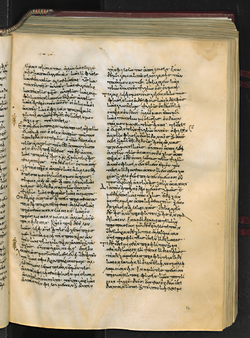Minuscule 832
| New Testament manuscript | |
 Folio 12 recto | |
| Text | Gospels, Catholic epistles † |
|---|---|
| Date | 10th century |
| Script | Greek |
| Now at | Laurentian Library |
| Size | 33 cm by 25 cm |
| Type | Byzantine text-type |
| Category | none |
| Note | commentary |
Minuscule 832 (in the Gregory-Aland numbering), A127 (von Soden),[1][2] is a 10th-century Greek minuscule manuscript of the New Testament on parchment. The manuscript has no complex contents.
Description
[edit]The codex contains the text of the Gospel of Matthew, Gospel of John, and Catholic epistles, on 251 parchment leaves (size 33 cm by 25 cm).[3][4] The text is written in two columns per page, 37 lines per page.[3][5] It has some lacunae (in Luke and Jude 3-25).[4]
It contains a commentary to the Catholic epistles.[4]
Text
[edit]Kurt Aland the Greek text of the codex did not place in any Category.[6]
It was not examined by Claremont Profile Method.[7]
History
[edit]Gregory dated the manuscript to the 10th century.[4] Currently the manuscript is dated by the INTF to the 10th century.[5]
The manuscript was examined and described by Angelo Maria Bandini.[8]
Formerly it was designated by 832e and 143a. It was added to the list of New Testament manuscripts by Gregory (832e). Gregory saw it in 1886.[4]
Currently the manuscript is housed at the Laurentian Library (Plutei VI. 5), in Florence.[3][5]
See also
[edit]References
[edit]- ^ Soden, von, Hermann (1902). Die Schriften des neuen Testaments, in ihrer ältesten erreichbaren Textgestalt / hergestellt auf Grund ihrer Textgeschichte. Vol. 1. Berlin: Verlag von Alexander Duncker. p. 251.
- ^ Gregory, Caspar René (1908). Die griechischen Handschriften des Neuen Testament. Leipzig: J. C. Hinrichs'sche Buchhandlung. p. 76.
- ^ a b c Aland, Kurt; M. Welte; B. Köster; K. Junack (1994). Kurzgefasste Liste der griechischen Handschriften des Neues Testaments. Berlin, New York: Walter de Gruyter. p. 95. ISBN 3-11-011986-2.
- ^ a b c d e Gregory, Caspar René (1900). Textkritik des Neuen Testaments. Vol. 1. Leipzig: J.C. Hinrichs. p. 225.
- ^ a b c "Liste Handschriften". Münster: Institute for New Testament Textual Research. Retrieved 23 January 2011.
- ^ Aland, Kurt; Aland, Barbara (1995). The Text of the New Testament: An Introduction to the Critical Editions and to the Theory and Practice of Modern Textual Criticism. Erroll F. Rhodes (trans.). Grand Rapids: William B. Eerdmans Publishing Company. p. 139. ISBN 978-0-8028-4098-1.
- ^ Wisse, Frederik (1982). The Profile Method for the Classification and Evaluation of Manuscript Evidence, as Applied to the Continuous Greek Text of the Gospel of Luke. Grand Rapids: William B. Eerdmans Publishing Company. p. 67. ISBN 0-8028-1918-4.
- ^ Angelo Bandini, Catalogus codicum manuscriptorum graecorum, latinorum, italicorum etc, Bibliothecae Mediceae Laurentianae (Florence 1767-1778), p. 100.
Further reading
[edit]- Gregory, Caspar René (1900). Textkritik des Neuen Testaments. Vol. 1. Leipzig: Hinrichs. p. 225.
- Angelo Bandini, Catalogus codicum manuscriptorum graecorum, latinorum, italicorum etc, Bibliothecae Mediceae Laurentianae (Florence 1767-1778), p. 100.
External links
[edit]- Biblioteca Medicea Laurenziana Catalogo Aperto
- Images at the Biblioteca Medicea Laurenziana
